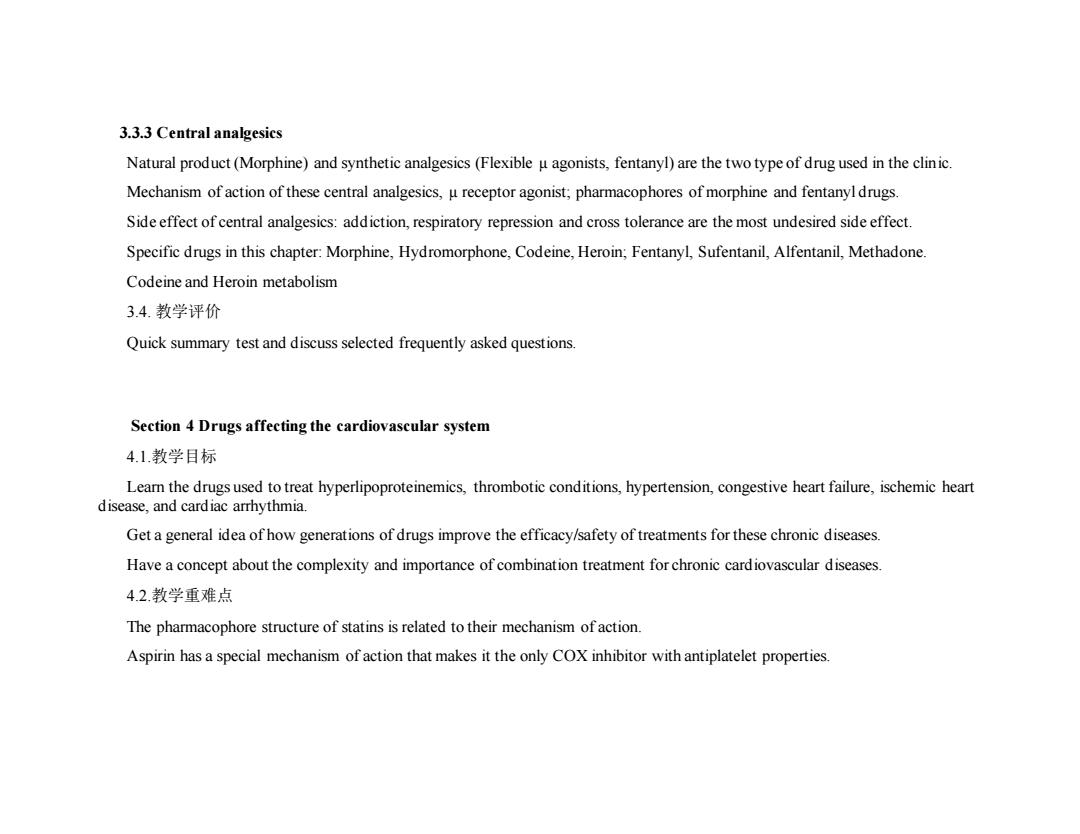正在加载图片...

3.3.3 Central analgesics Natural product(Morphine)and synthetic analgesics(Flexible u agonists,fentanyl)are the two type of drug used in the clinic. Mechanism of action of these central analgesics,u receptor agonist;pharmacophores of morphine and fentanyl drugs. Side effect of central analgesics:addiction,respiratory repression and cross tolerance are the most undesired side effect. Specific drugs in this chapter:Morphine,Hydromorphone,Codeine,Heroin;Fentanyl,Sufentanil,Alfentanil,Methadone. Codeine and Heroin metabolism 3.4.教学评价 Quick summary test and discuss selected frequently asked questions. Section 4 Drugs affecting the cardiovascular system 4.1.教学目标 Learn the drugs used to treat hyperlipoproteinemics,thrombotic conditions,hypertension,congestive heart failure,ischemic heart disease,and cardiac arrhythmia. Get a general idea of how generations of drugs improve the efficacy/safety of treatments for these chronic diseases. Have a concept about the complexity and importance of combination treatment for chronic cardiovascular diseases. 4.2.教学重难点 The pharmacophore structure of statins is related to their mechanism ofaction. Aspirin has a special mechanism of action that makes it the only COX inhibitor with antiplatelet properties.3.3.3 Central analgesics Natural product (Morphine) and synthetic analgesics (Flexible µ agonists, fentanyl) are the two type of drug used in the clinic. Mechanism of action of these central analgesics, µ receptor agonist; pharmacophores of morphine and fentanyl drugs. Side effect of central analgesics: addiction, respiratory repression and cross tolerance are the most undesired side effect. Specific drugs in this chapter: Morphine, Hydromorphone, Codeine, Heroin; Fentanyl, Sufentanil, Alfentanil, Methadone. Codeine and Heroin metabolism 3.4. 教学评价 Quick summary test and discuss selected frequently asked questions. Section 4 Drugs affecting the cardiovascular system 4.1.教学目标 Learn the drugs used to treat hyperlipoproteinemics, thrombotic conditions, hypertension, congestive heart failure, ischemic heart disease, and cardiac arrhythmia. Get a general idea of how generations of drugs improve the efficacy/safety of treatments for these chronic diseases. Have a concept about the complexity and importance of combination treatment for chronic cardiovascular diseases. 4.2.教学重难点 The pharmacophore structure of statins is related to their mechanism of action. Aspirin has a special mechanism of action that makes it the only COX inhibitor with antiplatelet properties